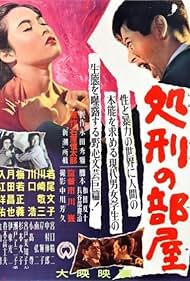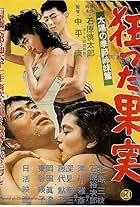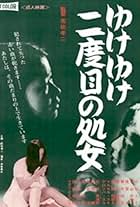Nothing less than a phenomenal, astonishing and pioneering film. This spectacle of an angry, ego-driven youth tormented by his own emotional impotence, low self-esteem and resentment towards... Read allNothing less than a phenomenal, astonishing and pioneering film. This spectacle of an angry, ego-driven youth tormented by his own emotional impotence, low self-esteem and resentment towards his parents.Nothing less than a phenomenal, astonishing and pioneering film. This spectacle of an angry, ego-driven youth tormented by his own emotional impotence, low self-esteem and resentment towards his parents.
Photos
Storyline
Did you know
- TriviaFinal film of Yôko Mikawa.
- ConnectionsReferenced in Century of Cinema: Nihon eiga no hyaku nen (1995)
Featured review
It was years ago that I stopped believing that there exists such a thing as "a typival Ichikawa film". For Ichikawa Kon is a director, who drifted from one genre to the next, producing a nice crop of masterworks, as well as some appallingly bad let-downs. As there is not a "typical" film for him, it is pointless to frame one of his films as "atypical". So let's just say that "Shokei no heya" (The Punishment Room, 1956) is one of those that most clearly stand out.
One recurring detail in Ichikawa's filmography is his keenness to adapt literature into film. "Shokei no heya" is based on Ishihara Shintaro's famous novel. This is a slimy and nihilistic work about young, violent men, that immediately brought to mind Kubrick's "A Clockwork Orange", even though the original novel for that film only came out in 1962. Even if the going does not get quite as absurd, this is also a challenging film to watch, a very brutal experience.
Stylistically, it's way ahead of the curve. I don't know if someone has already pointed it out, but this is a good candidate to be the "first Japanese new wave film", and in 1956 it was early. The film depicts two young men, with Katsumi (Kawaguchi Hiroshi, of later Masumura fame) being the protagonist. Apparently because they are constantly bored of their surroundings, the two boys create havoc wherever they go, as they live out their modern-day youth. They also try to cheat money from Katsumi's banker father, to support their hedonistic lifestyle. There is also academic discussion about philosophy, literature and society, which helps to tie the film better to its time period.
When Katsumi sees, that another boy in campus has a crush on beautiful Akiko (Wakao Ayako, also of later Masumura fame), we get the most shocking 10 minutes of the film. I am not going to disclose plot details, but if you are easily shocked by sexual violence in films, wouldn't recommend this one. It makes the protagonist so loathsome for the rest of the narrative, and the story then goes to places that feel really disturbing, especially for modern day viewers. Ichikawa must have had nerves of steel to push this film out in 1956, I can't even think how the censors must have viewed this. The director does not let his audience get off easy, and the more disturbing the scene, the longer it is let to play out. It is like a film by Rainer Werner Fassbinder at times.
What makes this even more difficult to assess for modern viewers is that Katsumi is not clearly portrayed to be disgustingly evil, but more-so a bored young man, who is testing his limits. This makes the morale of the film hard to pinpoint. Then again I have not read the book, which would probably clarify how we as the audience are supposed to view certain things, or at least how the author would like it. Not all of the philosophical points of the text translate to film in an understandable way.
The ending (no spoilers) works however, and brings to mind another famous closing scene that involved the actor Kawaguchi. He is, by the way, a great actor. He has such a basic face, that makes him fit very different types of roles, especially when working with a talented director like Ichikawa or Masumura. Even though the female role is written to be very uneven, and uncertain, Wakao Ayako is already a super star in this performance. The seriousness of her face provides haunting close-ups.
"Shokei no heya" is an important film. It's a difficult one, an unclear one, and not necessarily a "top 10" entry for the director. It is a youthfully shot, exciting conversation starter, and alongside "Nobi" (Fires on a Plain, 1959), the most shocking thing Ichikawa ever did.
One recurring detail in Ichikawa's filmography is his keenness to adapt literature into film. "Shokei no heya" is based on Ishihara Shintaro's famous novel. This is a slimy and nihilistic work about young, violent men, that immediately brought to mind Kubrick's "A Clockwork Orange", even though the original novel for that film only came out in 1962. Even if the going does not get quite as absurd, this is also a challenging film to watch, a very brutal experience.
Stylistically, it's way ahead of the curve. I don't know if someone has already pointed it out, but this is a good candidate to be the "first Japanese new wave film", and in 1956 it was early. The film depicts two young men, with Katsumi (Kawaguchi Hiroshi, of later Masumura fame) being the protagonist. Apparently because they are constantly bored of their surroundings, the two boys create havoc wherever they go, as they live out their modern-day youth. They also try to cheat money from Katsumi's banker father, to support their hedonistic lifestyle. There is also academic discussion about philosophy, literature and society, which helps to tie the film better to its time period.
When Katsumi sees, that another boy in campus has a crush on beautiful Akiko (Wakao Ayako, also of later Masumura fame), we get the most shocking 10 minutes of the film. I am not going to disclose plot details, but if you are easily shocked by sexual violence in films, wouldn't recommend this one. It makes the protagonist so loathsome for the rest of the narrative, and the story then goes to places that feel really disturbing, especially for modern day viewers. Ichikawa must have had nerves of steel to push this film out in 1956, I can't even think how the censors must have viewed this. The director does not let his audience get off easy, and the more disturbing the scene, the longer it is let to play out. It is like a film by Rainer Werner Fassbinder at times.
What makes this even more difficult to assess for modern viewers is that Katsumi is not clearly portrayed to be disgustingly evil, but more-so a bored young man, who is testing his limits. This makes the morale of the film hard to pinpoint. Then again I have not read the book, which would probably clarify how we as the audience are supposed to view certain things, or at least how the author would like it. Not all of the philosophical points of the text translate to film in an understandable way.
The ending (no spoilers) works however, and brings to mind another famous closing scene that involved the actor Kawaguchi. He is, by the way, a great actor. He has such a basic face, that makes him fit very different types of roles, especially when working with a talented director like Ichikawa or Masumura. Even though the female role is written to be very uneven, and uncertain, Wakao Ayako is already a super star in this performance. The seriousness of her face provides haunting close-ups.
"Shokei no heya" is an important film. It's a difficult one, an unclear one, and not necessarily a "top 10" entry for the director. It is a youthfully shot, exciting conversation starter, and alongside "Nobi" (Fires on a Plain, 1959), the most shocking thing Ichikawa ever did.
- topitimo-829-270459
- Dec 2, 2019
- Permalink
Details
- Release date
- Country of origin
- Language
- Also known as
- Комната насилия
- Filming locations
- Production company
- See more company credits at IMDbPro
- Runtime1 hour 36 minutes
- Color
- Sound mix
- Aspect ratio
- 1.37 : 1
Contribute to this page
Suggest an edit or add missing content

















